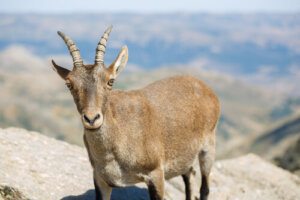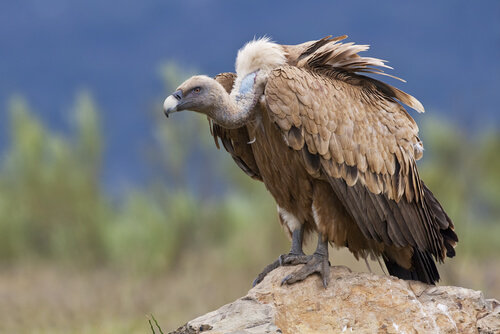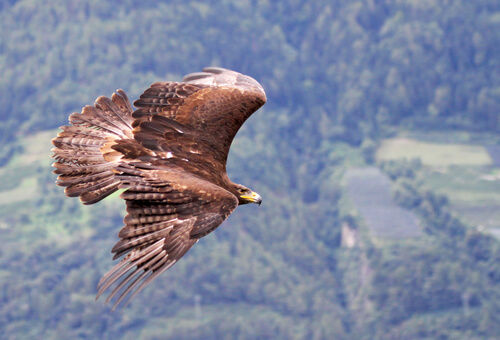7 Incredible High Mountain Animals

We’re struck by how these high mountain animals can survive in such adverse conditions. However, as the popular saying goes, “nature is wise”, and has allowed them to adapt to such circumstances. In this article, we’ll give you information about some species that inhabit the highest areas on the planet.
What’s the definition of “high mountain”?
To begin with, it’s worth mentioning some characteristics of the high mountain. It’s an elevated terrain with cold temperatures and precipitation in the form of snow. In addition, the vegetation is very sparse and this prevents certain animals from settling there.
Although the term ‘high mountain’ may differ from country to country, it’s estimated that from 2,500 meters upwards (about 1.5 miles), it can be considered as such. What no one can dispute is that at 3,000 meters (1.85 miles) above sea level the climatic conditions are harsher, and solar radiation is higher.
In this regard, it’s worth noting that the lack of oxygen is one of the main reasons why mammals and birds don’t tend to live in these areas. It certainly isn’t the most favorable environment.
High mountain animals
The fauna in this ecosystem is mostly characterized by invertebrates, and only a few vertebrates such as reptiles and birds. Some examples of high mountain animals are:
1. Goats
These animals can live in all environments that have a certain slope or elevation, as they have a body that’s adapted to both the cold and the rocks. They take the opportunity to eat during the early morning hours because, in addition to the grasses, they enjoy the dew that wets the leaves.
They’re able to climb without a problem and are characteristic in Switzerland, China, Iran, and Argentina.
2. Griffon vultures
This vulture is one of the few that live in Europe. It can survive high altitudes and mountainous areas cut with deep valleys.

They’re seen on the edges of cliffs and ravines at dawn, waiting for the heat to help them in their flight, as they take advantage of the rising breezes to move. In some cases, they migrate to warmer areas when winter arrives.
3. Red-legged frogs
This amphibian is one of the most widespread high mountain animals in the world, inhabiting Europe and much of Asia. It prefers to spend its adult life on land, and seeks out damp places to breed in spring. It has a robust body of up to nine centimeters (nearly 4 inches), with different colors and spots. The females are larger than the males.
4. Golden eagles
This is one of the most widely distributed birds on the planet, as it can be seen in North America, Asia, Africa, and Europe. In Europe, it’s common in the Alps and in the mountainous areas of the Iberian Peninsula.

It adapts very well to all environments and, if necessary, feeds on carrion. However, it prefers to hunt from the air thanks to its strong claws, hooked beak, excellent eyesight, and incredible speed.
5. Snow vole
This rodent, which weighs up to 70 grams (3 oz) and measures 140 millimeters (6 inches), has a grayish coat with brownish tones and a white belly. It inhabits mountainous areas of Europe and Asia, including the great massifs of the Alps, the Balkans, and the Carpathians.
It has adapted to rocky ecosystems up to 4,700 meters (15400 feet) above sea level. Although it’s herbivorous, it can also consume insects and usually stores food for the winter.
6. Common fire salamander
This is an amphibian of terrestrial and nocturnal habits – it only comes out during the day if it’s very humid. It only enters the water to lay its eggs and can be seen in European mountainous areas. It can measure up to 30 centimeters (12 inches) long and is characterized by its striking colors: black and yellow.

7. Pyrenean Chamois
This is a small-sized bovid found in the mountain ranges of southwestern Europe, including the Pyrenees, the Cantabrian, and the Apennine Mountains. Both males and females have hooked horns, a light-colored body, and spots on the face, and a short tail.
Finally, they breed between October and November, gestation lasts 20 weeks, and the female gives birth to a single calf at a time.
We’re struck by how these high mountain animals can survive in such adverse conditions. However, as the popular saying goes, “nature is wise”, and has allowed them to adapt to such circumstances. In this article, we’ll give you information about some species that inhabit the highest areas on the planet.
What’s the definition of “high mountain”?
To begin with, it’s worth mentioning some characteristics of the high mountain. It’s an elevated terrain with cold temperatures and precipitation in the form of snow. In addition, the vegetation is very sparse and this prevents certain animals from settling there.
Although the term ‘high mountain’ may differ from country to country, it’s estimated that from 2,500 meters upwards (about 1.5 miles), it can be considered as such. What no one can dispute is that at 3,000 meters (1.85 miles) above sea level the climatic conditions are harsher, and solar radiation is higher.
In this regard, it’s worth noting that the lack of oxygen is one of the main reasons why mammals and birds don’t tend to live in these areas. It certainly isn’t the most favorable environment.
High mountain animals
The fauna in this ecosystem is mostly characterized by invertebrates, and only a few vertebrates such as reptiles and birds. Some examples of high mountain animals are:
1. Goats
These animals can live in all environments that have a certain slope or elevation, as they have a body that’s adapted to both the cold and the rocks. They take the opportunity to eat during the early morning hours because, in addition to the grasses, they enjoy the dew that wets the leaves.
They’re able to climb without a problem and are characteristic in Switzerland, China, Iran, and Argentina.
2. Griffon vultures
This vulture is one of the few that live in Europe. It can survive high altitudes and mountainous areas cut with deep valleys.

They’re seen on the edges of cliffs and ravines at dawn, waiting for the heat to help them in their flight, as they take advantage of the rising breezes to move. In some cases, they migrate to warmer areas when winter arrives.
3. Red-legged frogs
This amphibian is one of the most widespread high mountain animals in the world, inhabiting Europe and much of Asia. It prefers to spend its adult life on land, and seeks out damp places to breed in spring. It has a robust body of up to nine centimeters (nearly 4 inches), with different colors and spots. The females are larger than the males.
4. Golden eagles
This is one of the most widely distributed birds on the planet, as it can be seen in North America, Asia, Africa, and Europe. In Europe, it’s common in the Alps and in the mountainous areas of the Iberian Peninsula.

It adapts very well to all environments and, if necessary, feeds on carrion. However, it prefers to hunt from the air thanks to its strong claws, hooked beak, excellent eyesight, and incredible speed.
5. Snow vole
This rodent, which weighs up to 70 grams (3 oz) and measures 140 millimeters (6 inches), has a grayish coat with brownish tones and a white belly. It inhabits mountainous areas of Europe and Asia, including the great massifs of the Alps, the Balkans, and the Carpathians.
It has adapted to rocky ecosystems up to 4,700 meters (15400 feet) above sea level. Although it’s herbivorous, it can also consume insects and usually stores food for the winter.
6. Common fire salamander
This is an amphibian of terrestrial and nocturnal habits – it only comes out during the day if it’s very humid. It only enters the water to lay its eggs and can be seen in European mountainous areas. It can measure up to 30 centimeters (12 inches) long and is characterized by its striking colors: black and yellow.

7. Pyrenean Chamois
This is a small-sized bovid found in the mountain ranges of southwestern Europe, including the Pyrenees, the Cantabrian, and the Apennine Mountains. Both males and females have hooked horns, a light-colored body, and spots on the face, and a short tail.
Finally, they breed between October and November, gestation lasts 20 weeks, and the female gives birth to a single calf at a time.
All cited sources were thoroughly reviewed by our team to ensure their quality, reliability, currency, and validity. The bibliography of this article was considered reliable and of academic or scientific accuracy.
- Pérez-Barbería, F. J., García-González, R., Palacios, B. (2010). Rebeco – Rupicapra pyrenaica. En: Enciclopedia Virtual de los Vertebrados Españoles. Salvador, A., Cassinello, J. (Eds.). Museo Nacional de Ciencias Naturales, Madrid. http://www.vertebradosibericos.org/
- Piñeiro, A. (2017). Topillo nival – Chionomys nivalis. En: Enciclopedia Virtual de los Vertebrados Españoles. Salvador, A., Barja, I. (Eds.). Museo Nacional de Ciencias Naturales, Madrid. http://www.vertebradosibericos.org/
- Ramos, G. S., & Villalón, M. L. (2007). Los ecosistemas de montaña y sus implicaciones en el cambio climático global. CienciaUAT, 2(2), 20-23.
- Álvarez-Romero, J. y R. A. Medellín. (2005). Odocoileus virginianus. Vertebrados superiores exóticos en México: diversidad, distribución y efectos potenciales. Instituto de Ecología, Universidad Nacional Autónoma de México. Bases de datos SNIB-CONABIO. Proyecto U020. México. D.F.
This text is provided for informational purposes only and does not replace consultation with a professional. If in doubt, consult your specialist.








